Page 110 of 698
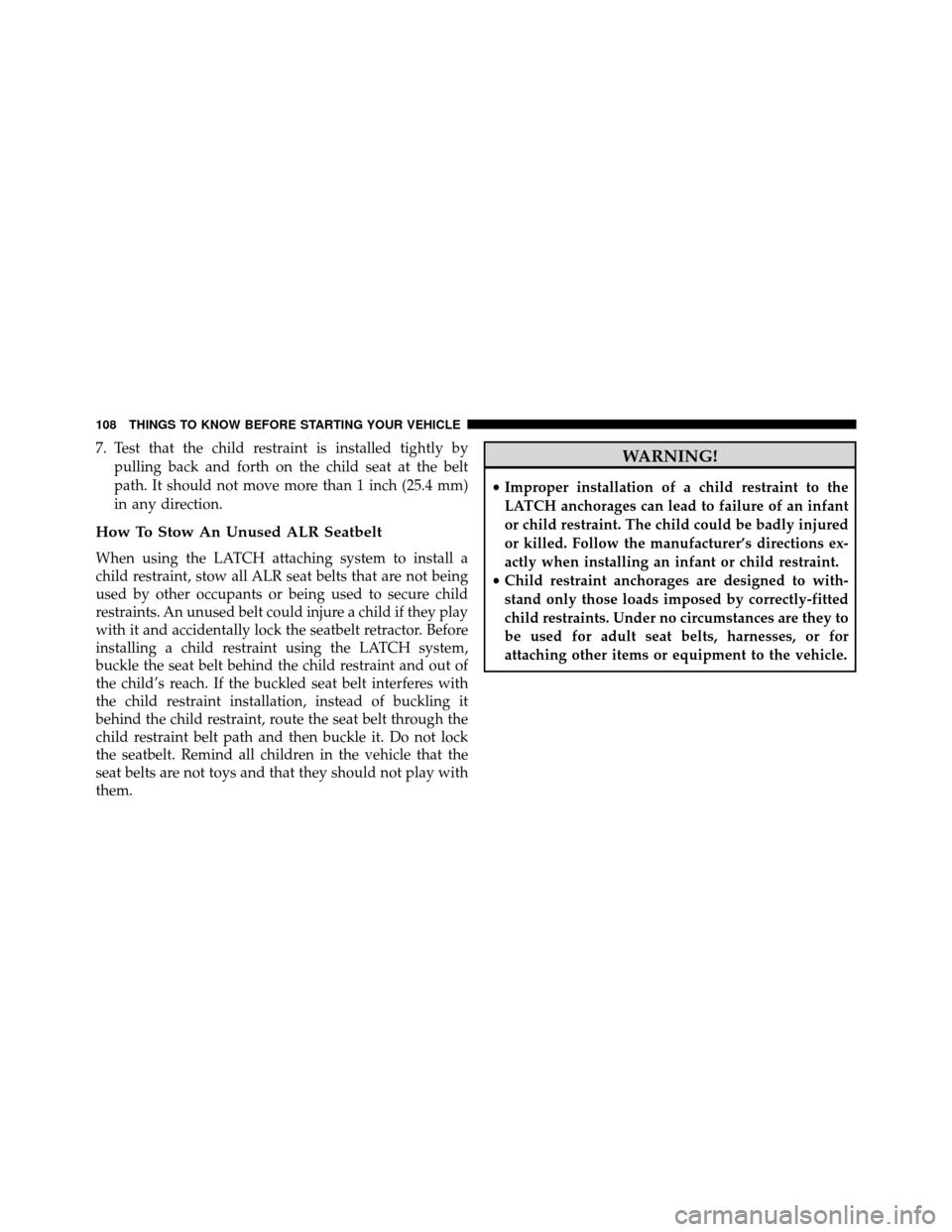
7. Test that the child restraint is installed tightly bypulling back and forth on the child seat at the belt
path. It should not move more than 1 inch (25.4 mm)
in any direction.
How To Stow An Unused ALR Seatbelt
When using the LATCH attaching system to install a
child restraint, stow all ALR seat belts that are not being
used by other occupants or being used to secure child
restraints. An unused belt could injure a child if they play
with it and accidentally lock the seatbelt retractor. Before
installing a child restraint using the LATCH system,
buckle the seat belt behind the child restraint and out of
the child’s reach. If the buckled seat belt interferes with
the child restraint installation, instead of buckling it
behind the child restraint, route the seat belt through the
child restraint belt path and then buckle it. Do not lock
the seatbelt. Remind all children in the vehicle that the
seat belts are not toys and that they should not play with
them.
WARNING!
•Improper installation of a child restraint to the
LATCH anchorages can lead to failure of an infant
or child restraint. The child could be badly injured
or killed. Follow the manufacturer’s directions ex-
actly when installing an infant or child restraint.
• Child restraint anchorages are designed to with-
stand only those loads imposed by correctly-fitted
child restraints. Under no circumstances are they to
be used for adult seat belts, harnesses, or for
attaching other items or equipment to the vehicle.
108 THINGS TO KNOW BEFORE STARTING YOUR VEHICLE
Page 118 of 698
4. Remove slack in the tether strap according to the childrestraint manufacturer ’s instructions.
WARNING!
•An incorrectly anchored tether strap could lead to
increased head motion and possible injury to the
child. Use only the anchorage position directly
behind the child seat to secure a child restraint top
tether strap.
• If your vehicle is equipped with a split rear seat,
make sure the tether strap does not slip into the
opening between the seatbacks as you remove
slack in the strap.
Transporting Pets
Air Bags deploying in the front seat could harm your pet.
An unrestrained pet could be thrown about and possibly
injured, or injure a passenger during panic braking or in
a collision.
Pets should be restrained in the rear seat in pet harnesses
or pet carriers that are secured by seat belts.
LATCH Anchorages (Third Row 60/40 Anchorage
Shown)
116 THINGS TO KNOW BEFORE STARTING YOUR VEHICLE
Page 119 of 698
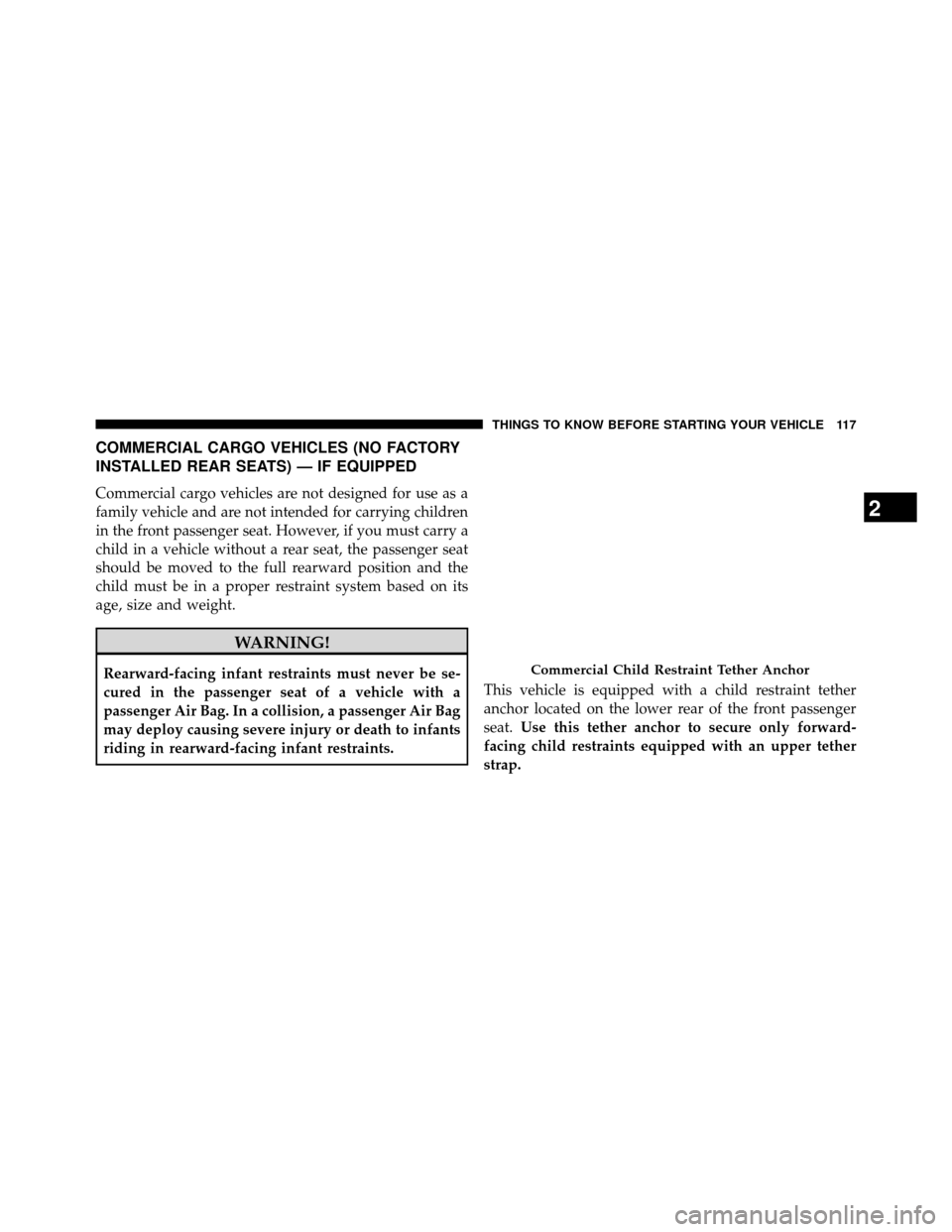
COMMERCIAL CARGO VEHICLES (NO FACTORY
INSTALLED REAR SEATS) — IF EQUIPPED
Commercial cargo vehicles are not designed for use as a
family vehicle and are not intended for carrying children
in the front passenger seat. However, if you must carry a
child in a vehicle without a rear seat, the passenger seat
should be moved to the full rearward position and the
child must be in a proper restraint system based on its
age, size and weight.
WARNING!
Rearward-facing infant restraints must never be se-
cured in the passenger seat of a vehicle with a
passenger Air Bag. In a collision, a passenger Air Bag
may deploy causing severe injury or death to infants
riding in rearward-facing infant restraints.This vehicle is equipped with a child restraint tether
anchor located on the lower rear of the front passenger
seat.
Use this tether anchor to secure only forward-
facing child restraints equipped with an upper tether
strap.Commercial Child Restraint Tether Anchor
2
THINGS TO KNOW BEFORE STARTING YOUR VEHICLE 117
Page 120 of 698
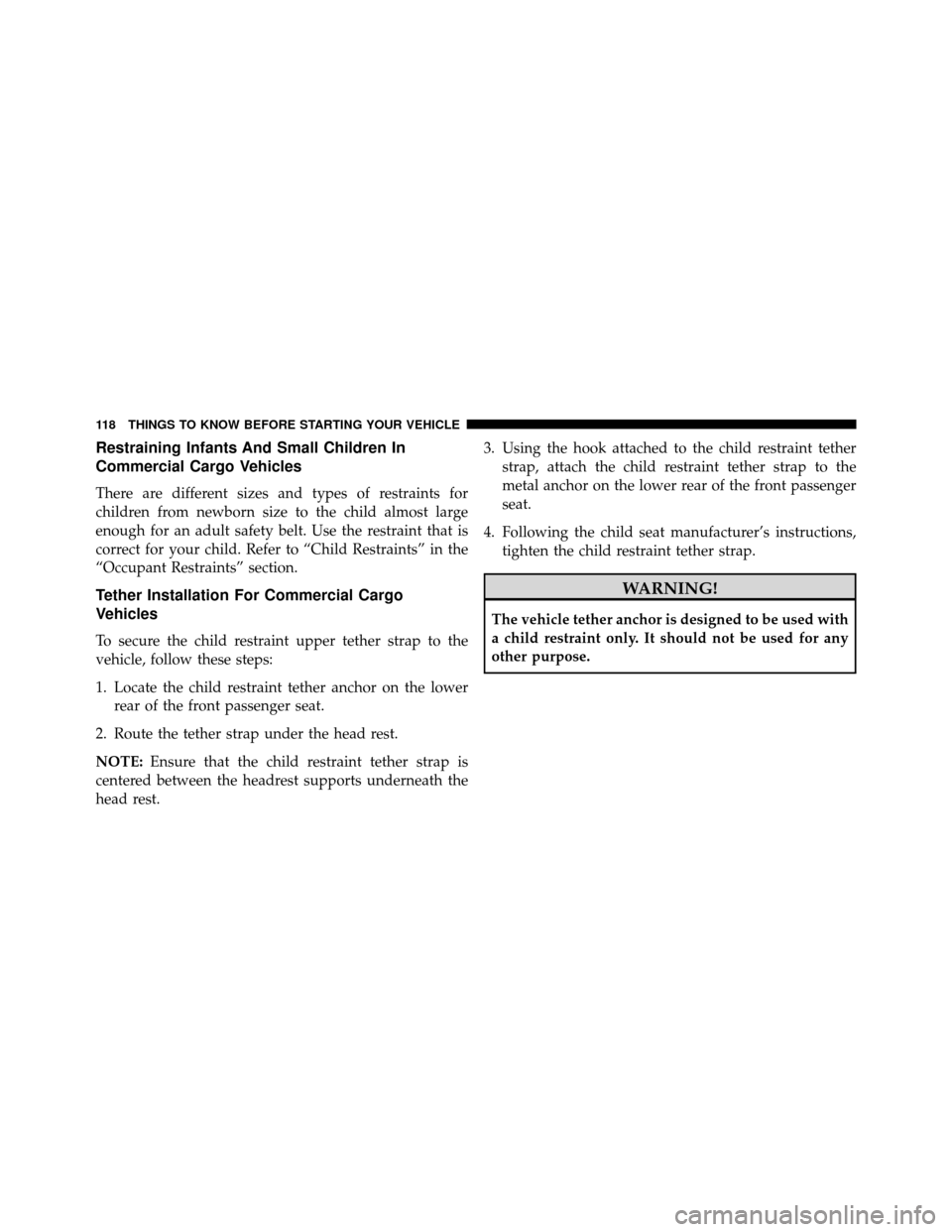
Restraining Infants And Small Children In
Commercial Cargo Vehicles
There are different sizes and types of restraints for
children from newborn size to the child almost large
enough for an adult safety belt. Use the restraint that is
correct for your child. Refer to “Child Restraints” in the
“Occupant Restraints” section.
Tether Installation For Commercial Cargo
Vehicles
To secure the child restraint upper tether strap to the
vehicle, follow these steps:
1. Locate the child restraint tether anchor on the lowerrear of the front passenger seat.
2. Route the tether strap under the head rest.
NOTE: Ensure that the child restraint tether strap is
centered between the headrest supports underneath the
head rest. 3. Using the hook attached to the child restraint tether
strap, attach the child restraint tether strap to the
metal anchor on the lower rear of the front passenger
seat.
4. Following the child seat manufacturer’s instructions, tighten the child restraint tether strap.
WARNING!
The vehicle tether anchor is designed to be used with
a child restraint only. It should not be used for any
other purpose.
118 THINGS TO KNOW BEFORE STARTING YOUR VEHICLE
Page 124 of 698

not lit during starting, see your authorized dealer. If the
light stays on, flickers, or comes on while driving, have
the system checked by an authorized dealer.
Defroster
Check operation by selecting the defrost mode and place
the blower control on high speed. You should be able to
feel the air directed against the windshield. See your
authorized dealer for service if your defroster is inoper-
able.
Floor Mat Safety Information
Always use floor mats designed to fit the footwell of your
vehicle. Use only floor mats that leave the pedal area
unobstructed and that are firmly secured so that they
cannot slip out of position and interfere with the pedals
or impair safe operation of your vehicle in other ways.
WARNING!
Pedals that cannot move freely can cause loss of
vehicle control and increase the risk of serious per-
sonal injury.
•Always make sure that floor mats are properly
attached to the floor mat fasteners.
• Never place or install floor mats or other floor
coverings in the vehicle that cannot be properly
secured to prevent them from moving and interfer-
ing with the pedals or the ability to control the
vehicle.
• Never put floor mats or other floor coverings on top
of already installed floor mats. Additional floor
mats and other coverings will reduce the size of the
pedal area and interfere with the pedals.
(Continued)
122 THINGS TO KNOW BEFORE STARTING YOUR VEHICLE
Page 125 of 698
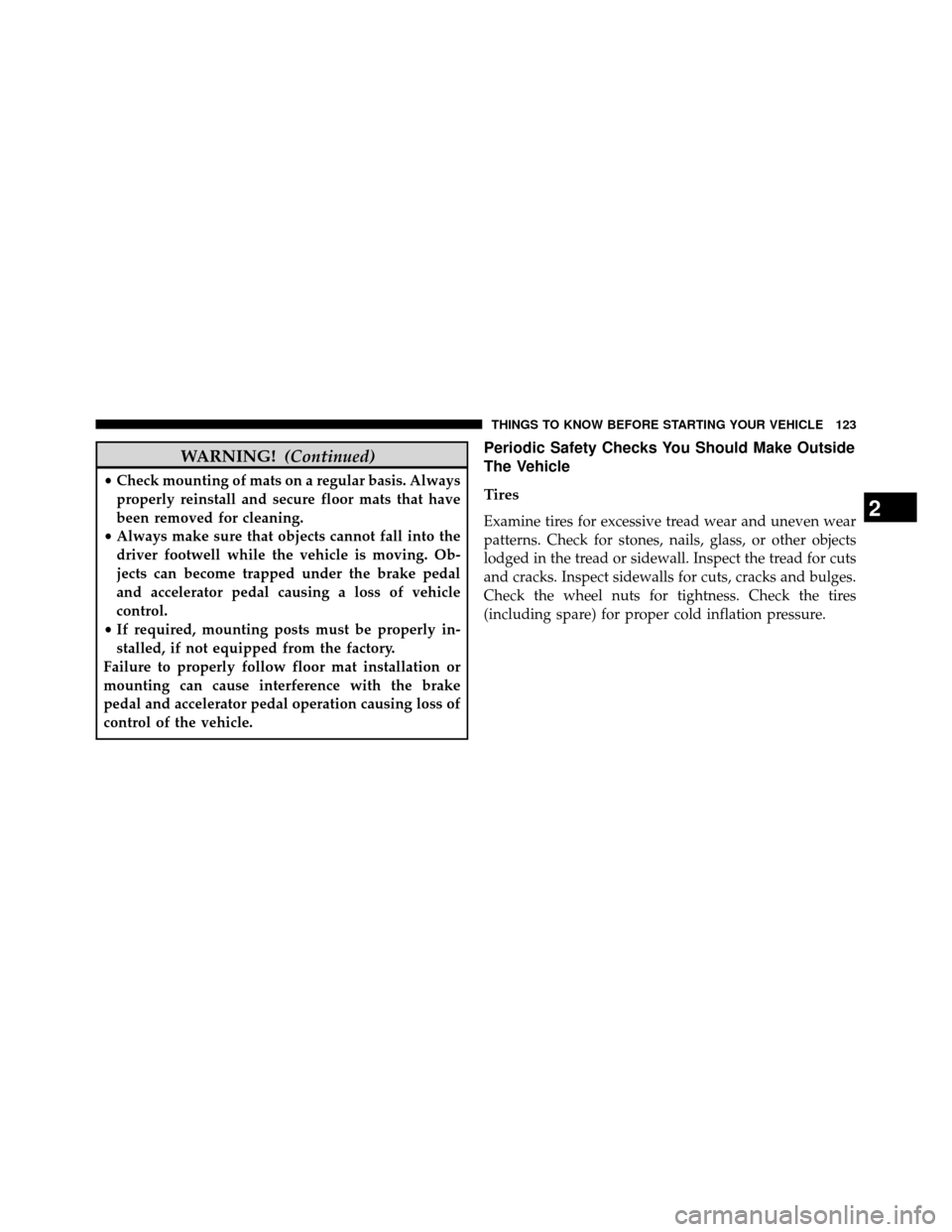
WARNING!(Continued)
•Check mounting of mats on a regular basis. Always
properly reinstall and secure floor mats that have
been removed for cleaning.
• Always make sure that objects cannot fall into the
driver footwell while the vehicle is moving. Ob-
jects can become trapped under the brake pedal
and accelerator pedal causing a loss of vehicle
control.
• If required, mounting posts must be properly in-
stalled, if not equipped from the factory.
Failure to properly follow floor mat installation or
mounting can cause interference with the brake
pedal and accelerator pedal operation causing loss of
control of the vehicle.
Periodic Safety Checks You Should Make Outside
The Vehicle
Tires
Examine tires for excessive tread wear and uneven wear
patterns. Check for stones, nails, glass, or other objects
lodged in the tread or sidewall. Inspect the tread for cuts
and cracks. Inspect sidewalls for cuts, cracks and bulges.
Check the wheel nuts for tightness. Check the tires
(including spare) for proper cold inflation pressure.2
THINGS TO KNOW BEFORE STARTING YOUR VEHICLE 123
Page 131 of 698
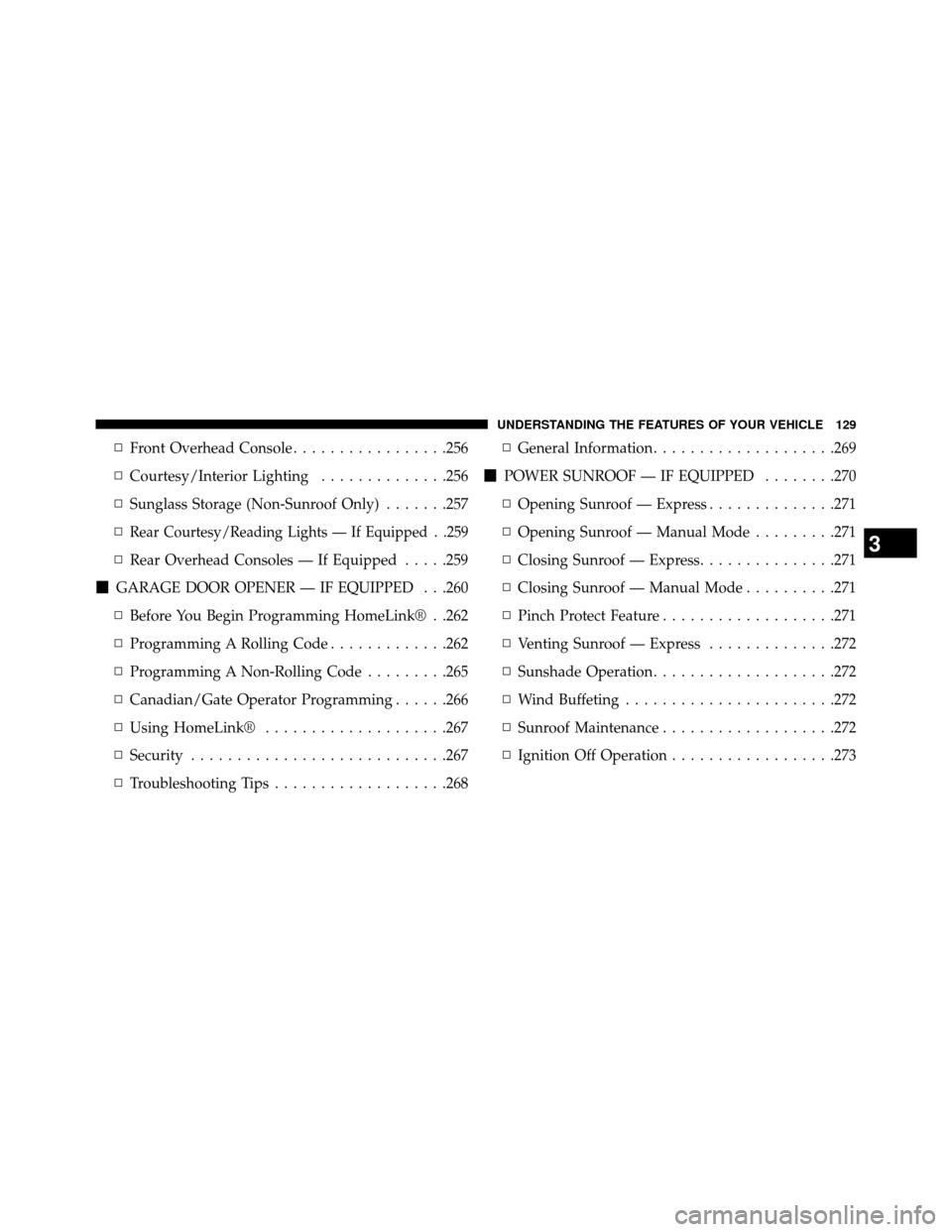
▫Front Overhead Console .................256
▫ Courtesy/Interior Lighting ..............256
▫ Sunglass Storage (Non-Sunroof Only) .......257
▫
Rear Courtesy/Reading Lights — If Equipped . .259
▫ Rear Overhead Consoles — If Equipped .....259
� GARAGE DOOR OPENER — IF EQUIPPED . . .260
▫ Before You Begin Programming HomeLink® . .262
▫ Programming A Rolling Code .............262
▫ Programming A Non-Rolling Code .........265
▫ Canadian/Gate Operator Programming ......266
▫ Using HomeLink® ....................267
▫ Security ............................267
▫ Troubleshooting Tips ...................268 ▫
General Information ....................269
� POWER SUNROOF — IF EQUIPPED ........270
▫ Opening Sunroof — Express ..............271
▫ Opening Sunroof — Manual Mode .........271
▫ Closing Sunroof — Express ...............271
▫ Closing Sunroof — Manual Mode ..........271
▫ Pinch Protect Feature ...................271
▫ Venting Sunroof — Express ..............272
▫ Sunshade Operation ....................272
▫ Wind Buffeting .......................272
▫ Sunroof Maintenance ...................272
▫ Ignition Off Operation ..................2733
UNDERSTANDING THE FEATURES OF YOUR VEHICLE 129
Page 200 of 698
WARNING!(Continued)
•Active Head Restraints may be deployed if they are
struck by an object such as a hand, foot or loose
cargo. To avoid accidental deployment of the Ac-
tive Head Restraint ensure that all cargo is secured,
as loose cargo could contact the Active Head Re-
straint during sudden stops. Failure to follow this
warning could cause personal injury if the Active
Head Restraint is deployed.
Head Restraints — Second Row Quad Seats
To raise the head restraint, pull upward on the head
restraint. To lower the head restraint, press the push
button, located at the base of the head restraint, and push
downward on the head restraint.
Head Restraints — Second Row Bench
If your vehicle is equipped with a second row bench seat,
the head restraints are not adjustable.
Push Button
198 UNDERSTANDING THE FEATURES OF YOUR VEHICLE